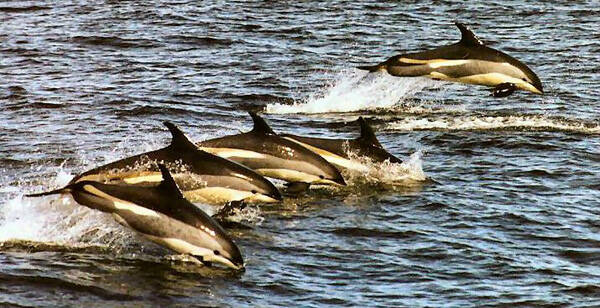Lagenorhynchus acutus
IUCN
LCBasic Information
Scientific classification
- name:Lagenorhynchus acutus
- Scientific Name:Atlantic white-sided dolphin, jumping dolphin, bouncing dolphin
- Outline:Cetacea
- Family:Delphinidae dolphin
Vital signs
- length:1.9-2.7m
- Weight:165-200kg
- lifetime:22-27years
Feature
Atlantic white-sided dolphin, jumping dolphin, bouncing dolphin
Distribution and Habitat
Origin (sea area): Belgium, Canada, Denmark, Faroe Islands, France, Greenland, Iceland, Ireland, Netherlands, Norway, Russia, Sweden, United Kingdom, United States.
Wandering place (sea area): Gibraltar, Portugal, Spain.
Inhabits waters near the continental shelf with a depth of 40~270 meters and a surface water temperature of 6~20℃; prefers to move along the higher terrain of the coastal bottom shelf.
Appearance
Adult length: male 2.2~2.7 meters, female 1.9~2.7 meters; weight 165~200 kilograms. Stout body.
Gently sloping forehead. Dark circles around the eyes. The upper part of the bill is black or dark gray, and the lower part is white or light gray. The sickle-shaped pectoral fins are black or dark gray, with sharp tips. Dark stripes extend from the corners of the mouth to the pectoral fins (with individual differences).
The dorsal fin is located slightly forward of the middle of the body, tall and sickle-shaped (more upright in adults), with a single black or dark gray color; there is a white band under the dorsal fin. The back of the body is black or dark gray. The abdomen is white, and light gray stripes are distributed along the entire body.
The tail shaft is very thick, with a distinct ridge, and suddenly narrows near the tail fin. There are yellow or yellow-brown blocks on both sides of the tail shaft. Both sides of the tail fin are black or dark gray, with sharp tips and the
Details
Atlantic White-sided Dolphin (scientific name: Lagenorhynchus acutus) is also known as Atlantic White-sided Dolphin. It has no subspecies. Atlantic White-sided Dolphin is currently classified in a polymorphic genus (Cipriano 1997). However, molecular biological studies have shown that this species is not closely related to other species in the same genus, so this species may be separated from Lagenorhynchus in the future and classified into Leucopleurus, forming a new monomorphic genus (LeDucet al. 1999, Harlin-Cognato and Honeycutt 2006).

Atlantic spotted dolphins are fast swimmers with aerial prowess. They often leap up to hit the waves (although not as often as white-beaked spotted dolphins or true dolphins) and strike the waves with their tails. They rise to the surface to breathe about every 10 to 15 seconds, either completely out of the water or just slightly out of the water, creating ripples above their heads. They are wary of boats in some areas, but will accompany slow boats or bow-ride in front of fast boats; sometimes they ride the front waves of large whales. Dives last no more than 5 minutes.
Atlantic spotted dolphins are gregarious, usually in groups of 5-50, but groups of more than 1,000 have been found offshore. Groups found offshore are usually larger than those along the coast. Strandings are common along the North Atlantic coast; usually in pairs, but small groups of 3-5 (or more) are also common.

Atlantic spotted dolphins are highly mobile in their area, but there is no evidence that they make seasonal migrations, and their geographic distribution patterns are related to the abundance of their main foraging species. The diet is usually a mix of shrimp, smelt, cod, squid, and herring. They will leave the group to forage efficiently.
Males reach sexual maturity at 2.1-2.4 meters in length. Females reach sexual maturity at 1.94-2.22 meters in length, which may correspond to the age of 12 years. The gestation period is about 10 months, and the calves are born in June and July. Usually there is one calf per litter, and the average newborn weighs 25 kilograms and is 107-122 centimeters long. The lactation period is 18 months; the calving interval is 2-3 years. The maximum lifespan of females is 22 years, and that of males is 27 years.

There are about 51,640 (CV=38%) on the east coast of North America (Waringet al. 2006). There are about 96,000 (CV=54%) on the west coast of Scotland (Mac Leod 2004). In the western North Atlantic, according to survey records from July to September 1995, there are an estimated 27,000 individuals from the southern edge of the Gulf of Maine, the northeastern North American shelf to the continental slope waters of the Cabot Strait (Palkaet al. 1997), and at least 11,740 (CV=47%) individuals in the Gulf of St. Lawrence (Kingsley & Reeves 1998).
Listed in Appendix II of the Convention on International Trade in Endangered Species of Wild Fauna and Flora (CITES).
Listed in China's "List of National Key Protected Wildlife": National Class II Protected Animals (effective December 10, 1988, Cetacean*Other Cetaceans).
Listed in the IUCN Red List of Threatened Species: Least Concern (LC), assessed in 2008.
Protect wild animals and stop eating game.
Maintaining ecological balance is everyone's responsibility!








